New York Occupy Wall Street Rally Draws Thousands of Teachers, Union Members
The rally that began around 3 o'clock on Wednesday, October 5, 2011, in Manhattan, followed by a march to the Liberty Square-Zuccotti Park Occupy Wall Street encampment. It had several remarkable features. The most obvious, and one that couldn't be missed, even by the corporate media, was the broad participation of organized labor. Another was the joyful and celebratory mood like some huge previously-unseen public waking up to itself in the middle of the day. Everybody seemed as cooperative and generous in spirit as they were fired-up. Another major feature was the not-so-sudden presence of students and teachers in the gathering.
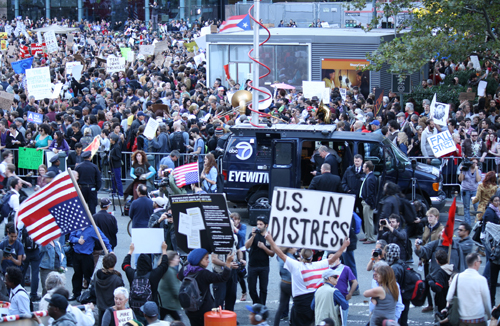 Part of the massive crowd at the October 5, 2011 Occupy Wall Street rally in New York City. Substance photo by John Lawhead.To illustrate the last point, I was walking across Center Street when I heard a reporter from WPIX television calling out, "Teachers? Any teachers here? I'm looking for a UFT teacher who can tell the public why you're here." My mouth dropped as I wonder what other public is she talking about? And I continued to scan the scene through my camera's viewfinder having almost no doubt that even in a crowd of tens of thousands there would be a teacher within earshot.
Part of the massive crowd at the October 5, 2011 Occupy Wall Street rally in New York City. Substance photo by John Lawhead.To illustrate the last point, I was walking across Center Street when I heard a reporter from WPIX television calling out, "Teachers? Any teachers here? I'm looking for a UFT teacher who can tell the public why you're here." My mouth dropped as I wonder what other public is she talking about? And I continued to scan the scene through my camera's viewfinder having almost no doubt that even in a crowd of tens of thousands there would be a teacher within earshot.
The endorsement of the Transit Workers of America, Local 100, will no doubt be seen as a turning point in the broadened base of support. The union's executive board expressed approval of the Occupy Wall Street encampment's stance against the destructive, overwhelming influence of corporations on the country and praised the young people for their courage in being a catalyst during such bleak times. The Communication Workers of America leadership credited the activists for their participation in pickets during the Verizon strike. The National Nurses United was also an early endorser and its members have participated in the occupation of public space in Boston during their convention there this week.
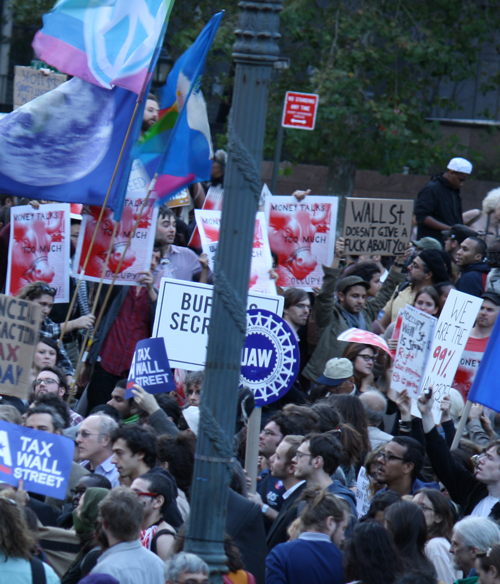 "Wall Street Doesn't Give A Fuck About You" was one of the many handmade signs at Occupy Wall Street. Substance photo by John Lawhead.The amazing labor presence at the rally included not only unions previously known for militancy but also rank-and-file members of conservative hardhat unions. There were public employees, retail and service workers, iron and steel workers, musicians, actors, artists and free lancers. There were anti-war and human rights activists, parties of the radical left, numerous environmentalists and neighborhood activists as well. Across the plaza one could see tight huddles of bobbing, chanting, singing, drum-pounding, sign-laden students from CUNY and other area colleges.
"Wall Street Doesn't Give A Fuck About You" was one of the many handmade signs at Occupy Wall Street. Substance photo by John Lawhead.The amazing labor presence at the rally included not only unions previously known for militancy but also rank-and-file members of conservative hardhat unions. There were public employees, retail and service workers, iron and steel workers, musicians, actors, artists and free lancers. There were anti-war and human rights activists, parties of the radical left, numerous environmentalists and neighborhood activists as well. Across the plaza one could see tight huddles of bobbing, chanting, singing, drum-pounding, sign-laden students from CUNY and other area colleges.
Much of the spirit drew on direct experiences relating to the occupation and the previous support marches, the novel elements of the occupation with it's projects in participatory democracy, popular education and media to the harrowing struggle to defend a public space under attack and intimidation by the NYPD.
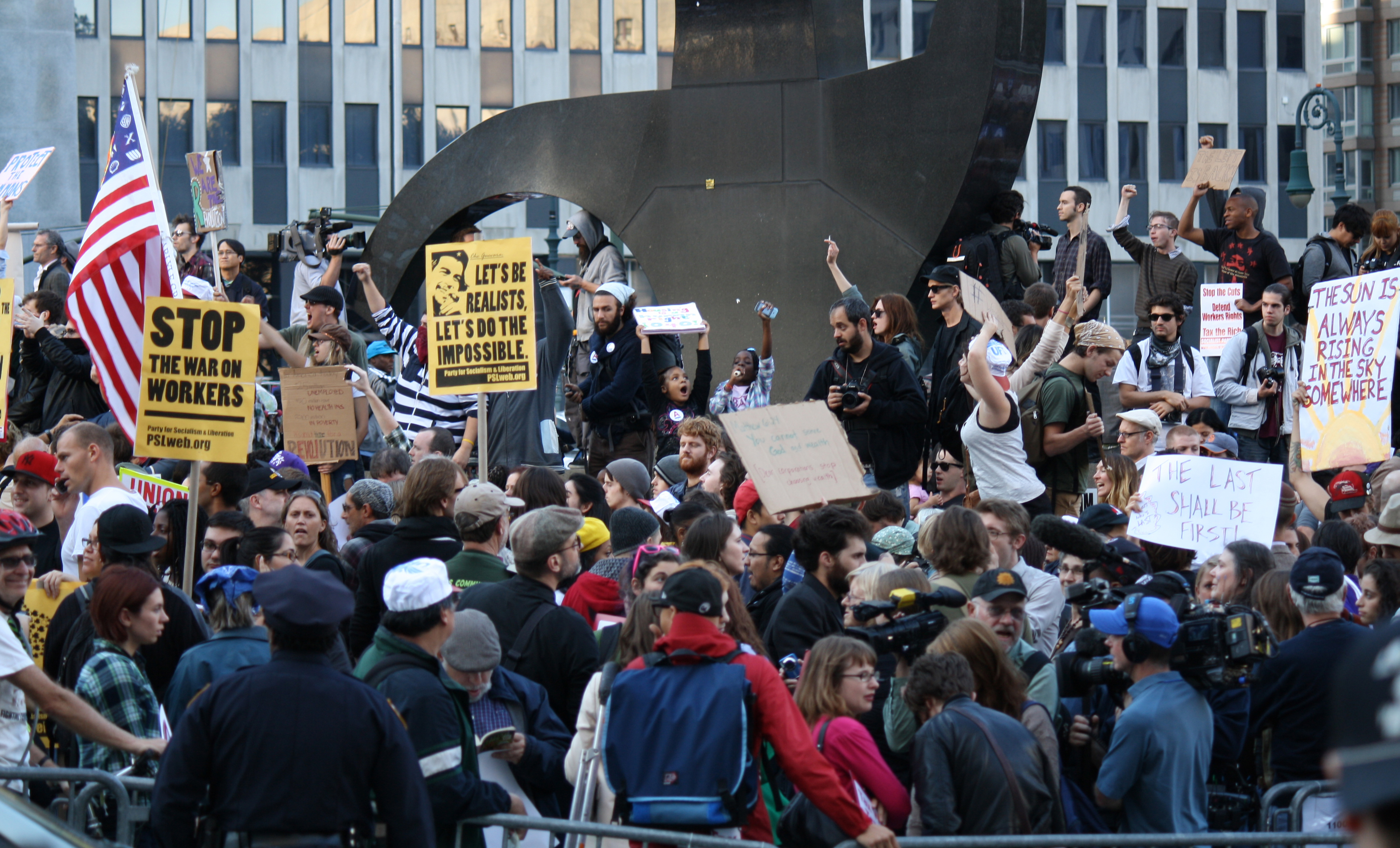 One of the many panoramas from Occupy Wall Street. Substance photo by John Lawhead.The New York Times ran a front-page the day following the rally that featured the president of “The labor movement needs to tap into the energy and learn from them,” Stuart Appelbaum, of the UFCW, saying, “They are reaching a lot of people and exciting a lot of people that the labor movement has been struggling to reach for years.” The Times piece was focused with acute alarm on the appearance of labor-leftwing unity to the exclusion of much else. There was no mention of the huge presence of CUNY students, or that there had been walkouts at numerous campuses in the area and nationwide earlier in the day.
One of the many panoramas from Occupy Wall Street. Substance photo by John Lawhead.The New York Times ran a front-page the day following the rally that featured the president of “The labor movement needs to tap into the energy and learn from them,” Stuart Appelbaum, of the UFCW, saying, “They are reaching a lot of people and exciting a lot of people that the labor movement has been struggling to reach for years.” The Times piece was focused with acute alarm on the appearance of labor-leftwing unity to the exclusion of much else. There was no mention of the huge presence of CUNY students, or that there had been walkouts at numerous campuses in the area and nationwide earlier in the day.
Juan Gonzalez in his Daily News column, published the day of rally, had it right when he observed that the “establishment critics” have “no clue what is happening.” Gonzalez wrote that “by setting up camp near the scene of Wall Street's still-unpunished crimes, and by persevering round the clock for nearly three weeks, these kids have created a boot camp for social change.”
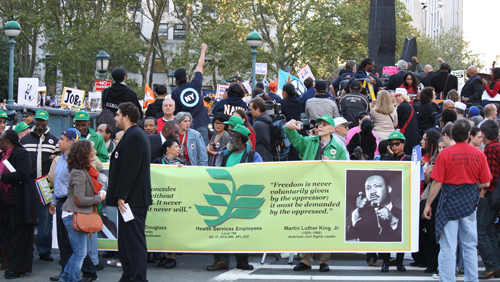 Health workers union (AFSCME) used two classical quotations from leaders of previous struggles to bring the new crowd at Occupy Wall Street into the same historical traditions. Substance photo by John Lawhead.However, Gonzalez also drew a somewhat distorted contrast of a unified “now” versus a discordant “then,” taking as his point of departure the days of 1970 when construction workers viciously beat anti-war protesters on the same streets of downtown Manhattan. He declared happily, “Now the young people and the unions are on the same side.”
Health workers union (AFSCME) used two classical quotations from leaders of previous struggles to bring the new crowd at Occupy Wall Street into the same historical traditions. Substance photo by John Lawhead.However, Gonzalez also drew a somewhat distorted contrast of a unified “now” versus a discordant “then,” taking as his point of departure the days of 1970 when construction workers viciously beat anti-war protesters on the same streets of downtown Manhattan. He declared happily, “Now the young people and the unions are on the same side.”
It's really not so simple as that, and it's no small point in the city's labor history that around the time of the hardhat riots union leaders, especially those representing public employees with increasing numbers of minorities in their ranks, brought pressure on the city and the state to dramatically improve higher education. It seems to be largely forgotten nowadays that New York City's Central Labor Council and the UFT played an important part in winning the establishment of the CUNY open admissions policy in 1969.
That experiment, which required a huge expenditure even by the standards of the day, was launched following a tumultuous year of direct action by Black and Puerto Rican students, including occupations at City College, and the Queens College and Brooklyn College. According to Joshua Freeman in Working-Class New York: “Of the 100,000 students who entered the City University during the first three years of open admissions, 48,000 would not have qualified under prior admission standards.” He goes on to note that more than half of the students admitted during those years eventually received B.A. degrees.
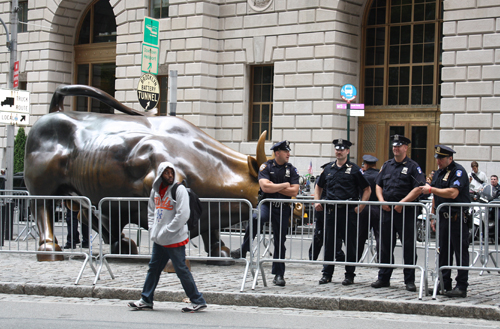 Everybody knows that this three and a half ton cartoon bull needs to be fucked with. It's completely uncivic. Since everybody knows that everybody knows there's not much left to do except let it be guarded 24/7 through the next nine years or whatever of cut-backs, cut-offs, cut-down, layoffs and cutting. The investment in overtime and tedium is very nearly inevitable since if left unprotected and no longer actively detested across the barriers it might fade within the mind's eye of passersby into just another Disney-type tourist-friendly artifact of the Bloomberg excesses.
Everybody knows that this three and a half ton cartoon bull needs to be fucked with. It's completely uncivic. Since everybody knows that everybody knows there's not much left to do except let it be guarded 24/7 through the next nine years or whatever of cut-backs, cut-offs, cut-down, layoffs and cutting. The investment in overtime and tedium is very nearly inevitable since if left unprotected and no longer actively detested across the barriers it might fade within the mind's eye of passersby into just another Disney-type tourist-friendly artifact of the Bloomberg excesses.
Substance photo by John Lawhead. It's probably safe to say no experiment in American education since then has had anything ressembling that kind of success, in spite of the voluminous rhetoric about “increasing opportunity for all.” It would seem that having a militant student movement, like it is now, allied with a teacher union less beholden to the corporation's agenda, like it will be hopefully soon, would be a good way to get back on track toward experiments in education that amount to something positive.
That the UFT leadership hastily followed the more militant unions into endorsing the rally hardly provides cover for the fact that not only aren't we finding a better direction but our union is complicit in all the excesses of mayoral control, the denial of funding for small classes, the destruction of school communities, the mass excessing of senior teachers, the dumbing down of both pedagogy and curriculum, and the adoption of a new national package of uniform standards, abusive testing and lockstep curriculums.
These issues are hardly a matter for teachers to lay at the feet of the union leadership. There's been a deep malaise of apathy and resignation among the membership as well. But this seems like a moment to rethink some of our politics during a time of broadening alliances and possibly a cross-fertilization of ideas.
VARIOUS RECENT MEDIA REPORTS BEGIN BELOW HERE, EACH IDENTIFIED PRIOR TO ITS POSTING (IN ITALICS)
Whose Side Are You On: The Moral Clarity of Occupy Wall Street By Robert Borosage
October 7, 2011 - 2:21pm ET http://www.ourfuture.org/blog-entry/2011104007/whose-side-are-you-moral-clarity-occupy-wall-street
Once Occupy Wall Street demonstrations started to sweep across America, the mainstream media began to pay attention — and sounded a chorus of criticism. The movement was disorganized; it had no agenda. It wasn't organized like the Tea Party. Fox News trotted out ace reporter Geraldo Rivera — really — to charge that European anarchists, paid illegal aliens, and out and out leftists were behind the innocent kids. Herman Cain led disapproving Republicans, calling the movement "un- American," when he should have been celebrating what it was doing for pizza sales.
Virtually everything said about this movement is wrong. Stand back; take a clear look. Every politician should understand one thing: this is coming at you and you must decide. Whose side are you on?
1. Moral clarity
Occupy Wall Street has no policy agenda, but it has utter moral clarity. The demonstrators have built an island of democracy in the belly of Wall Street. The bankers looking down on them would be on the street had not taxpayers bailed them out. And now they are confronted with students sinking under student debt with no jobs, homeowners who are underwater and can't find mortgage relief, workers desperate for work.
No one is confused about the message. Wall Street got bailed out; Main Street was abandoned. The top 1% rigs the rules and pockets the rewards. And 99% get sent the bill for the party they weren't even invited to.
2. Non violent discipline
That moral clarity was dramatized when the demonstrators stayed disciplined in the face of police provocation, including pepper spray in the face. The movement did not begin to sweep the country until people saw the police protecting Wall Street's banksters by assaulting peaceful protestors. Suddenly this wasn't a disorganized, rag tag gathering. These were citizens under attack for exercising their rights. That struck a powerful moral chord.
3. A Rising Protest
Across the country, people have responded to this clarity. Unemployed kids rallied to their side. White- collar workers stopped by for lunch. Suburbanites came in to share. On Wall Street, Liberty Square became a tourist center.
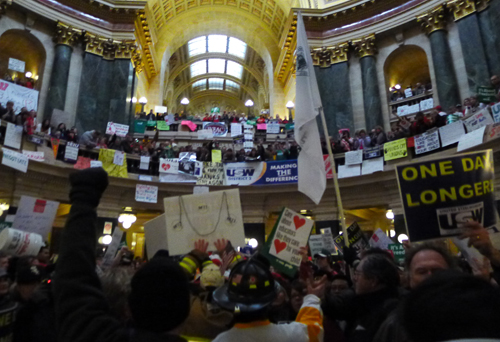 Part of the inspiration for the Occupy Wall Street movement were the protests in Madison Wisconsin at the beginning of the Republican Governor's attack on worker rights. Above, the rotunda of the Wisconsin State Capitol building on February 21, 2011. Substance photo by Garth Liebhaber.Unions and national progressive organizations marched in support, without pretending to speak for the demonstrators. For progressives, this surge of protest began building months ago, when thousands of people rallied to take over the capitol building in Madison, Wisconsin to protest Gov. Scott Walker's attempt to crush worker rights. It built over the summer as thousands turned up at town meetings and sobered legislators with their demand for jobs, not cuts. The Washington Post suggested that unions and national organizers were resentful of Occupy Wall Street, but in fact most were buoyed by the energy unleashed, the moral challenge posed.
Part of the inspiration for the Occupy Wall Street movement were the protests in Madison Wisconsin at the beginning of the Republican Governor's attack on worker rights. Above, the rotunda of the Wisconsin State Capitol building on February 21, 2011. Substance photo by Garth Liebhaber.Unions and national progressive organizations marched in support, without pretending to speak for the demonstrators. For progressives, this surge of protest began building months ago, when thousands of people rallied to take over the capitol building in Madison, Wisconsin to protest Gov. Scott Walker's attempt to crush worker rights. It built over the summer as thousands turned up at town meetings and sobered legislators with their demand for jobs, not cuts. The Washington Post suggested that unions and national organizers were resentful of Occupy Wall Street, but in fact most were buoyed by the energy unleashed, the moral challenge posed.
4. Political Steamroller
Pundits dismiss Occupy Wall Street for not having a clear agenda. They are told to turn their protests into political demands. Some offer suggestions of what they should advocate — "infrastructure investment" says Paul Krugman, a speculation tax on banks, home mortgage
relief. The press wonders if Occupy will become the left-wing Tea Party and run candidates in elections, as if left-wing Koch brothers were orchestrating the protests.
But this is silly. Occupy Wall Street is already a political steamroller. Without an agenda, without an electoral operation, without a slate of candidates, if it continues to grow, it will force every national politician to decide whose side he or she is on. Are you with the banks or with the 99%? And prove it. Reporters will insure the question gets posed; voters will be interested in the answer.
This is a question that discomfits the White House, as Vice President Joe Biden admitted, since the administration bailed out the banks without reforming them. It is a question that exposes Republicans -- particularly Tea Party Republicans -- the ersatz populists who brayed against the bank bailout in the election, and then have worked tirelessly to rollback any reforms, gut the Consumer Financial Protection Bureau, and reopen the financial casino. It is a question, as the demonstrators show, not simply about the banks. The demonstrators demand action on jobs. And they want Wall Street to pay us back — not cuts in Medicare or student loans or schools.
And these challenges are likely to grow more stark. Mass unemployment is continuing. More and more Americans are losing their homes. More kids are graduating from school into the worst jobs scene in decades. Big banks are in increasing legal and financial peril for their pervasive fraud and abuses in the housing bubble. Independent Attorneys General like New York State's Eric Schneiderman have launched investigations. Investors are collecting on lawsuits.
If this economy continues to stagnate or slow, which seems increasingly likely, banks like Bank of America are going to looking for another bailout. And once more, every national politician, from the president on down, will have to decide whose side they are on.
5. It's Only Just Begun
No one can predict what happens to Occupy Wall Street, but the public protests have just begun. When the Civil Rights Movement took off, it too faced many of the same criticisms. It had too many demands. Its priorities were unclear. Did it want only to overturn legal segregation? Why was King going to Chicago? Why was he talking about poverty, and not just about equal rights? How dare he talk about the war?
But King wasn't the only voice. There were competing and complementary centers of power. There were lawyers and lobbyists. Students in SNCC chafed at King's caution. Black power challenged integration. Riots shook the country.
Movements aren't tidy. They aren't organized. They unleash energy. They inspire ordinary people to leave their daily routines and do extraordinary things. They inspire; they insult; they mortify. They disrupt business as usual. And if they touch a chord, they grow, and they force politicians and citizens to decide.
Historically, when America has reached the levels of extreme inequality and corruption that it now witnesses, popular movements arise to demand change. The populist movements of the late 19th century took on the Robber Barons. Unions, left parties, Huey Long and his "every
man a King" movement pushed Roosevelt from the left in the 1930s. And now, even as pundits were wondering where the left was, the eruption is beginning again.
Will this movement be a factor in the 2012 elections? It already is. Will it make clear demands? It already has. Whose side are you on? Wall Street or kids in the street? The top 1% or the 99%? It doesn't get clearer than that.
Provided by: www.portside.org
FAIR COMMENTS ON THE CORPORATE MEDIA BLACKOUT ON OCCUPY WALL STREET THAT LASTED THROUGH MOST OF SEPTEMBER...
Whitewashing the Blackout of Occupy Wall Street (10/04/2011 by Jim Naureckas)
I checked out a post from the Web-based publication Capital (9/28/11) about media coverage of the Occupy Wall Street protest because CJR (9/29/11) told me it was a "smart post" that "crunched the numbers" and showed "how there really is no media blackout." I have to say I would have thought CJR would have higher standards when it came to crunching media numbers.
Capital's Joe Pompeo states his thesis early on:
The idea that there is a media blackout has gained appeal on the left with support from Michael Moore and Keith Olbermann, who said on the September 21 edition of his primetime show on Current TV: "The majority of the media is ignoring the public uprising."
In fact, an (admittedly unscientific) survey of news organizations suggests the protest, despite lacking any clear goal or purpose (that's by design), has been making headlines since it began on September 17.
OK, so Pompeo is trying to show that Olbermann was wrong when he said on September 21 that "the majority of the media" was ignoring the protest. (Michael Moore made a similar statement on the Rachel Maddow Show on September 19.) He does this by doing Nexis and Google searches that include a full week of additional coverage:
A Nexis query for "Occupy Wall Street" yielded 428 results as of press time [i.e, September 28], including 248 items that appeared on blogs, 71 in newspapers, 63 on the wires, 31 in "Web-based publications," 18 as news transcripts, nine as "aggregate news sources," one in the industry trade press and one in a legal news publication. Google News has indexed more than 2,000 articles between September 17 and today.
That is "admittedly unscientific" — not to mention patently unfair.
How much coverage had Occupy Wall Street actually gotten when Olbermann made his claim? Well, Nexis gives me 17 articles from September 16 through September 21 in the "Newspaper Stories, Combined Articles" database with the words "Occupy Wall Street" in them. Of these, 10 are from overseas papers--from Britain, Australia, Canada, China and Pakistan. Another four are from the St. Joseph News Press, a Missouri paper that reprints tiny items from CNN's wire service. So when Olbermann made his comment, there had been three actual U.S. newspaper stories during five days of demonstrations in the heart of the nation's media capital--the New York Daily News (9/17/11), Newark Star Ledger (9/18/11) and New York Newsday (9/19/11)--that are at least in-depth enough to mention the name of the event. That's a grand total of 1,047 words.
That Newsday piece, by the way, was headlined "Protests Close Wall Street Second Day." Nothing to see here — move along!

